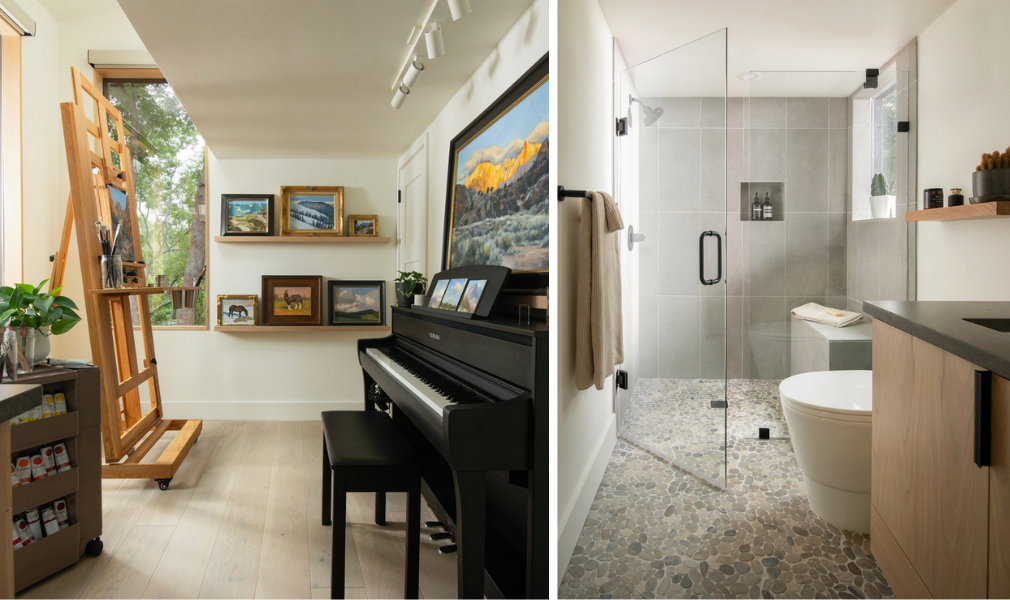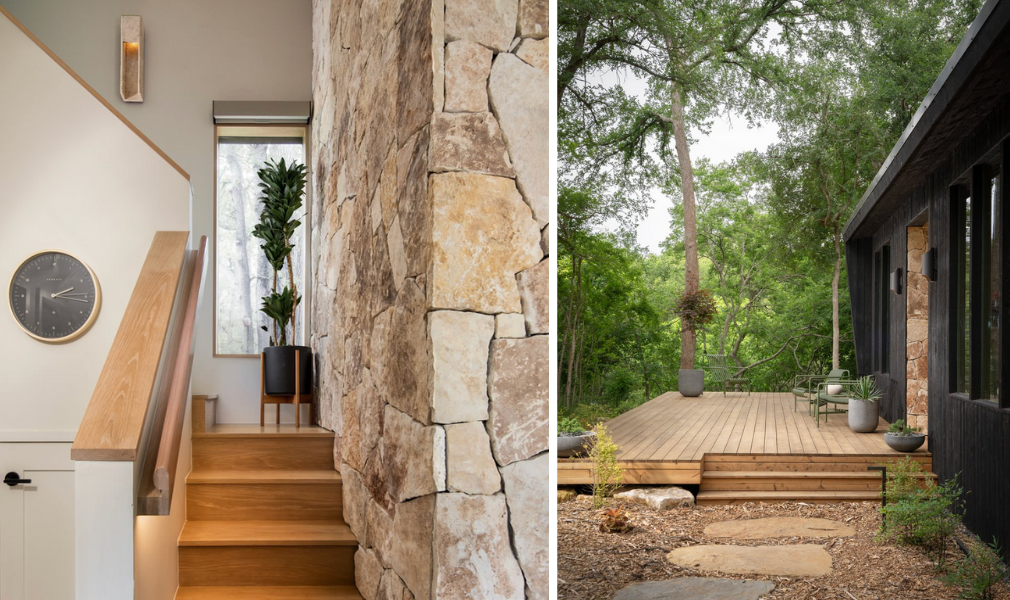Bringing creativity into your everyday life takes on a new dimension when you’re designing a personal space that serves both as a workplace and a sanctuary. For artist, designer, and architect Isaac French, The Nook—a stunning backyard retreat by his Texas home—was born from a passion for good design, craftsmanship, and the desire to create a space that fuels his creativity. This project is not only a testament to Isaac’s talent and dedication but also serves as a living example of how thoughtful, intentional design can inspire others to build their own creative havens.

With a blend of natural and native materials, a focus on multi-functionality, and a deep connection to the surrounding environment, Isaac approached The Nook as more than just an office—it’s a place where he can recharge, collaborate, and unleash his full creative potential. Keep reading to learn more about Isaac’s journey, the inspiration behind The Nook, and his advice for anyone looking to create their own creative space at home.
Tell us a little bit about yourself: Where are you based, and how did you become a designer, architect, and entrepreneur in the field of experiential hospitality?
“I was born in Waco, Texas, but my family moved to Idaho when I was 12, and I lived there for 10 years before returning to Texas in 2020. I never had formal training in architecture or design, but my first project—Live Oak Lake—was the pivot point of my career. I’ve always been creative, enjoying painting and drawing, but I also grew up in an entrepreneurial family and gained construction experience as early as high school. My grandfather was a builder, so it’s in my DNA.

On the topic of Live Oak Lake, what’s the origin story of that beautiful project?
“In 2020, I had the vision for the seven Nordic-inspired cabins in Waco that became Live Oak Lake. I designed and built them all myself and then started renting them out and basically created an experiential hospitality business from there. That opened the door to do the other work that I do, including essentially designing and building my personal office, The Nook. I’ve always loved design as an enthusiast, but I never really designed my own spaces until Live Oak Lake.”

Can you share some of the pivotal influences and other projects that have shaped who you are today as a designer and architect and your particular taste and design choices?
“A combination of childhood experiences shaped my design sensibilities. My grandfather was a fine home builder in Texas, and he’d take my siblings and me to job sites, exposing us to high-end craftsmanship. My parents also emphasized traditional skills like woodworking and blacksmithing, which deepened my love for craft and attention to detail. I naturally gravitated toward architecture, applying that appreciation to beautiful spaces.
Later, while working in commercial construction with my dad, I was inspired by some of the projects we worked on with architect Olson Kundig. Another pivotal project was a classroom showroom for the University of Idaho’s College of Natural Resources, which won an award. I was only 17 at the time, just transitioning out of high school, but it left a lasting impression.
Live Oak Lake and The Nook were heavily influenced by all of these experiences. The Nook, in particular, was a more refined evolution of my style—blending local materials like Texas limestone and cowhide with my love for Nordic and Scandinavian architecture, which was fostered during my years in the Pacific Northwest.”

Let’s talk about The Nook—your personal office, art studio, and guest quarters in your backyard. What inspired you to create this space, and how did you approach its multipurpose design?
“When I was working on Live Oak Lake, I had no dedicated office—just an iPad in my small living room or working on-site. I felt the need for a creative space, immersed in nature, where inspiration could flow. My grandfather, a homebuilder, had a tiny office where I spent time as a kid, playing under his desk while he drafted. The ambiance—the perfect lighting, gentle music, and the scent of my grandmother’s homemade soap—left a lasting impression. I always imagined having my own space like that.
After selling Live Oak Lake, I finally had the time and resources to build it. Behind our house was a three-acre jungle I had never explored because it was so dense. Clearing it took months, but once we did, I discovered a dry creek and beautiful trees—an ideal setting. Over six or seven days, I sketched different designs on my iPad, aiming for something simple, potentially movable, but adaptable for guests. I wanted a tiny house that combined an office, art studio, library, kitchen, bathroom, and guest accommodations, all nestled into the landscape. A week later, we broke ground. The design evolved as we built, allowing me to refine every detail along the way.”

You’ve described The Nook as a fusion of Japanese, Scandinavian, and Texan aesthetics, featuring charred-cedar cladding, white oak interiors, and native limestone. How did you harmonize these diverse materials and styles to create a cohesive environment?
“Combining aesthetics is always interesting to me. Without formal design training, I’ve learned by observing great designers and drawing inspiration from the architecture I admire. I’ve always loved the look of Shou Sugi Ban siding and the minimalist aesthetic of Japanese and Nordic architecture, and I wanted to adapt that to the Texas environment.
I enjoy juxtaposing contrasting elements—melding the raw, rustic texture of hand-chiseled Texas limestone with the clean, sleek lines of white oak felt like a compelling contrast. I incorporated these materials throughout the design, from the monolithic limestone wall anchoring the staircase to the subtle echoes in the lighting, like the limestone sconces.
Not having traditional architecture training has been an advantage—I never feel constrained by design “rules.” I approach projects from first principles, experimenting with what makes sense to me rather than adhering to conventions. Live Oak Lake was my first major exploration of this, The Nook was an evolution, and my next project will continue refining these ideas while making them even more my own.”

What were some of the significant challenges you encountered during the design and construction of The Nook, and how did you overcome them?
“One challenge was finding subcontractors who could meet my exacting standards for detail. It was hard to find people in the area willing or capable of putting in the care I wanted, so I ended up doing some of it myself, especially toward the end. But I was fortunate to have a fantastic team of craftsmen.
A key element of the build was the custom cabinetry and woodwork, and I had a good friend, a chairmaker, who did an amazing job with the cabinets. I also found a skilled stone mason who brought the same craftsmanship to the stonework. While there were struggles and adjustments along the way, [it was] nothing major.
We did go a bit over budget—common with passion projects—but I wasn’t willing to compromise on key elements. One of the toughest parts was choosing the right furniture. I went through six or seven chairs, ordering them and testing them on-site to see what worked. It took several iterations, but in the end, I’m thrilled with the result.”

How has The Nook influenced your daily life and creative endeavors since its completion?
“Having The Nook has been incredible. It’s just 200 feet from our home, making it easy to work but also go back and forth effortlessly throughout the day. My wife and I have two young boys, and it’s great that our older son often joins me in the space, playing while I work. It’s similar to how I grew up with my grandfather, and I’m excited to hopefully pass on a sense of excellence and appreciation for good design to my son as he grows.
The Nook also serves as a great spot for friends and clients to visit. It’s rewarding to show them not just talk about, but share what I care about, allowing them to touch and see the materials in person. It’s exceeded every expectation and has had a huge impact on my creativity. Whenever I hit a creative wall, I simply step outside for a walk, [to reconnect] with nature and [get] re-inspired. The space allows me to recharge and focus on work when needed.
The Nook really is about reconnecting and recharging as a creative person. When I need to focus and get a lot of work done, it allows me to do that, too. But sometimes, I feel like there’s too much going on, and I struggle to find time for things like drawing or painting because of other projects, community work, calls, and travel. Honestly, I wish I had more hours in the day to spend here doing all the things I love, because there’s so much I enjoy, and the space has been so powerful for that. Plus, it’s been amazing to host friends and family when they visit. They love staying here, and we love having them right in our backyard—it’s been such a rewarding aspect of the space.”

You’ve let people in on every detail of The Nook, from blueprints to design choices. What do you hope people take away from this particular project? Do you have any dreams about the impact The Nook may have on not just the design world, but the greater world?
“I want to inspire people to understand that achieving your dreams takes time and sacrifice, but it’s often more attainable and faster than you might think. I never expected to have a space like The Nook this soon, but by staying focused and taking it one step at a time, it came together more quickly than I imagined. My message is: Be committed to your dreams for the long term, but don’t be surprised if they come to fruition sooner than expected.
Having a dedicated space to recharge creatively is so important. For me, The Nook has become a core part of my routine and identity. I view it as one of my most important investments because it’s where I do my best work and draw inspiration. Whether it’s a small room or a larger space, investing in a place that fulfills you creatively is key. I like to think of it as a creative gym, where I can exercise all my creative muscles. Right now, I’m working on a portrait, and the energy I get from that process spills over into all my other projects. Everyone deserves a space like this to fuel their creativity.”

Could you highlight some of your favorite features from The Nook now that it’s more lived in?
“One of my favorite features is the little sitting area in the office space. I’m sometimes surprised by how much time I spend just sitting on the couch or in my chair by the tree. Whether I’m reading a book or working on my laptop, having a casual setting really helps me relax and, I think, do my best work. The shift in posture from sitting at my desk to relaxing in a more informal space really makes a difference.
Another feature I love is the kitchenette. It’s a nice little splurge, and I really enjoy having cold drinks and snacks right here whenever I need them. And of course, having the little play space for my son has been amazing. It’s great for him, and it’s also really helpful for his mom when he can visit me and get a little time away. He loves being here, and I love having him around while I work.”

When starting a new project, what does your creative process look like? Do you begin with a specific aesthetic in mind, or does function drive the design first?
“There’s definitely a dance between function and aesthetics. If it’s not functional, what’s the point? And if it’s not aesthetic, what’s the point? Great design is all about finding that seamless way to marry both. When I start a new project, I spend a lot of time just collecting ideas, especially on Pinterest, and more importantly, observing what others have done—what I like, what I don’t like.
It took me four months to build The Nook, which was really fast, but I had years of preparation before that. During that time, I figured out my own rhythms, understood what was necessary for the space, and prioritized the essentials, like how to allocate square footage. I think this is similar to what writers say: you spend 95% of your time preparing to write and only 5% actually writing. The same applies in design—it’s all about feeling it out and thinking things through before diving into the build.
One other important thing I’ve learned is how valuable experience in construction has been. Working alongside incredible designers but also with some who were impractical or too theoretical has taught me a lot. Even a little experience in construction, like being in the shoes of a contractor or carpenter, helps you understand the mechanics of the build. From a practical perspective, it helps you find creative ways to meet your goals efficiently and cost-effectively while still ensuring quality. Everyone has a budget and limitations, and for me, the challenge is to create amazing design within those constraints, which always leads to finding the most effective solutions through hands-on experience all the way around.”

How do you approach selecting materials for your projects, and what factors are most important in your decision-making process?
“I think the key to selecting materials is having an open mind, but also a lot of preparation before you dive into it. You need to experience other projects, other materials, and settings. Keep an open mind about what works and what doesn’t in your own environment. See what works for other people, what doesn’t, and how different elements might come together—what works in one setting might pair perfectly with something from another.
I think hospitality design has a lot to offer when it comes to creating great spaces. Hospitality spaces often nail the vibe like no one else does, and there’s so much to learn from how they approach materials, lighting, and other key design decisions. For me, traveling and experiencing unique nature hotels has been a huge source of inspiration. I pay close attention to the constituent parts of what makes these spaces work.
When it comes to materials, a lot of what we used in The Nook is similar to what we did at Live Oak Lake. White oak surfaces, flooring, cabinetry, and the counters and backsplashes were all very similar or identical. I’ve developed a real fondness for those materials over time. But I’m always open-minded, going to new spaces, seeing what others are doing, and seeking ways to incorporate other textures or materials into my own projects.
One last thing I’d add is the importance of honoring the place you’re building in. For example, we used the Texas limestone here at The Nook, which was directly sourced from our backyard. I wanted to reflect the natural surroundings, blending the structure with the environment. It’s about harmonizing with what’s already there while still adding creative elements that stand out. We didn’t want to impose something entirely new, but rather work with what’s already present in nature, reflecting it back in the design.”

What advice would you give to someone—whether an aspiring designer or simply a homeowner—who wants to create a unique, thoughtfully designed space like The Nook?
“I think tuning into a level of self-awareness is one of the most important things you can do when designing a space, whether you’re an aspiring designer or a homeowner. Pay attention to the spaces and environments that truly excite you, that fire you up. This is crucial because if you can learn to see how different environments make you feel—how the built environment affects you—you’ll naturally develop a sense of taste.
I’ve taken a lot of inspiration from hospitality spaces, nature hotels, and even some residences that resonated with me. While I never encountered an office or studio like The Nook, I applied lessons from hospitality and nature to create a workspace that felt both inspiring and functional.
Tune into what excites you. Pay attention, put your antenna up, and start collecting those moments or data points of why certain spaces or elements inspire you. This gives you a kind of guide or a ‘GPS’ to creating a space that’s uniquely yours. Whether it’s a backyard, a room in your house, or a client project, your space should reflect what truly excites and motivates you—not just what you think will look nice because someone else did it.
For me, nature has always been the place where I feel most alive, and I think that’s true for most people. So, tying your space back to nature in some way is a great way to anchor it. You’ll see that in The Nook—both inside and outside. It’s all about the windows, the views, the positioning under the trees. Inside, we’ve got over 30 live plants scattered throughout, which makes a huge difference in how vibrant and alive the space feels.
As a design principle, nature is timeless. It’s never going to go out of style. So, building a space around nature is a safe bet—it will always feel relevant and fresh. That’s why I believe the more you harmonize with nature, take cues from it, and make it a central part of your design, the more lasting and meaningful your space will be.”
To stay inspired and keep up with Isaac French’s latest projects and design insights, subscribe to his newsletter, visit his website, and follow him on Instagram and X for a closer look at his work and creative journey.








